________________
THE INDIAN ANTIQUARY
(FEBRUARY, 1916.
of Tinne velly and placed his head at the feet of Visvanatha. But these claims are evidently myths. The Pandyan valour was so guided by prudence and resource that when six months elapsed, and thousands of lives had been lost on both sides, Visvanatha was not an inch nearer his goal. The friends and admirers of Visvanatha have, at this stage, veiled his lack of victory under a superfluity of romance. Highly aggrieved, it is said, by the loss of co much blood and the sacrifice of so many souls for his sake, Visvanatha proposed at the instance of the Kannivadi chief, if we are to believe in the MS. history of that Palayam-to his opponents that the fate of the war should be decided by a personal combat, that the defeated party should give up the claim and the struggle for royalty, and become perpetual exiles, They agreed, and in the extensive arena between the two armies, on which stood & pillar to which a copy of the proposed agreement was attached, the Baduga Viceroy and the Tamil chiefs were, it was resolved, to measure their strength in a hand-to-hand fight. The duel was about to begin when, we are informed, a singular controversy took place between the antagoniste,-a controversy which gives & vivid picture of the chivalry of those days. The Five Pâņdyas said that it was against the law of war that five should fight against one, and that they would therefore select one of themselves as their champion. His success or failure, they said, was to mean their own success or failure. Visvanatha gave the characteristic answer that, as he desired to deprive all the five of their lands and realms, it was but equitable to meet all of them. His adversaries, however, were obstinately noble ; and the duel began between their champion and Visvanatha. The chronicles describe the combat in detail; but it is sufficient for us to note that the Baduga royal athlete was more than a match for his Tamil opponent; and the latter, in spite of three chances which his generous antagonist gave him for offensive action, was slain. The rest of the Pandyans, therefore, we are told, surrendered their arms and their lands, and became perpetual exiles to their country and their power. One imaginative chronicle adds that the Gods were so much struck with their noble adherence to truth that they showered flowers on them in the field of combat; and the Five Pandyans had to console themselves with the agreeable and philosophic reflection that, if they became poor in wealth and power, they became rich in glory; if they became exiles to their kingdom, they ensured their entry into heaven; and that if they were humiliated by men, they obtained the admiring veneration of the Gods !
Pandyan Dynasty not extinct.- Ativira-Rama-Pandya's accession. So ended the last of the Pandyans, and, if we are to believe the chronicles, the Baduga rulers were secure in future from troubles in that quarter. Inscriptions however clearly disprove this version. They point out clearly that the Pandyan dynasty did not become extinct. They might have been, indeed they were, defeated ; and some of them perhaps became exiles. But there is no doubt whatever that the Tenkasi dynasty continued to rule. Their defeat or exile, if there was any, must have been a temporary misfortune. For we actually know that, in 1563 or 1564, the son of Tirunelveliperuma! Kulasekhara, the celebrated Ati-Vira-Rama Pandya? whose name is well-known in the history of Tamil Literature, came
16 According to one MS, on which Wilson based his article in J. A. R. S. III, Visvanatha died of wound in this duel. I have not found this stated in any MS. I have seen. Wheeler takes this version.
& History of the Karnataka Govre.
7 The actual date of his coronation was Monday, 20th of Chitrai, of year RaktAkshi, S. 1486. His coronation title was Sivala.vēl (Trav. Arch., 106). According to ono version he was the elder son, the younger son being one "Bri-Vallabhs." It is this younger son, Sri Vallabha, that is considered by Mr. Gopinatha Rao to be the joint donor of the Pudukko, 41 plates in 1683. But Mr. Krishna Sastri says that Ati-Vira-Rama himself, who was also called Sri Vallabha, was the donor. See Trav. Arch. Series, p. 57. Madr. Manu. attributes him wrongly to the 11th century. (1, p. 67 and 121).




